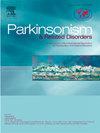Exploring the Nicotine-Parkinson's disease link – Insights from the UK Biobank
IF 3.1
3区 医学
Q2 CLINICAL NEUROLOGY
引用次数: 0
Abstract
Introduction
Evidence suggests an inverse correlation between smoking and Parkinson's disease (PD), yet the mechanisms remain unclear. This study examines the changing risk relationship between smoking and PD diagnosis using alcohol consumption, another reward-driven behavior, as a comparative measure.
Methods
A nested case-control study was conducted using the UK Biobank (UKBB) database. Participants in the prediagnostic phase of PD were identified, and self-reported data on tobacco and alcohol use were analyzed employing conditional binary logistic regression. Polynomial and piece-wise regression models were employed to discern shifting associations with PD over time.
Results
Of 502,304 participants (63 ± 5.3 years, 63 % male), 3049 prediagnostic PD cases were identified. Non-smokers had a heightened PD risk, and this association strengthened closer to diagnosis. The odds ratio (OR [95 % CI]) associated with PD in non-smokers was 2.02 [1.07–3.81] 1–4 years before diagnosis, compared to 1.36 [1.02–1.83] at >10-year intervals (linear trend, p = 0.012). The time trajectory of ORs was best depicted by a quadratic function, identifying a shift in risk 7.5 years before diagnosis documentation. Similar patterns emerged among alcohol non-consumers, with an 8.5-year interval inflection point.
Conclusion
This study identified two disparate risk trajectories among non-smokers: an initial low-amplitude increased risk at prolonged prediagnostic intervals possibly related to genetic/personality factors, followed by a sharp escalation in risk association commencing 7–8 years before diagnosis, possibly propelled by reverse causality. Similar trends in alcohol consumption reinforce these conclusions. These findings could suggest that smoking cessation may serve as an early indicator of PD.
探索尼古丁与帕金森病的联系--来自英国生物库的启示
导言有证据表明吸烟与帕金森病(PD)之间存在反相关性,但其机制仍不清楚。本研究以另一种奖赏驱动行为--饮酒作为比较指标,研究吸烟与帕金森病诊断之间不断变化的风险关系。方法利用英国生物库(UKBB)数据库开展了一项嵌套病例对照研究。研究人员对处于帕金森病诊断前阶段的参与者进行了识别,并采用条件二元逻辑回归分析了自我报告的烟草和酒精使用数据。结果 在502304名参与者(63±5.3岁,63%为男性)中,发现了3049例诊断前帕金森病病例。非吸烟者患帕金森氏症的风险较高,这种关联在临近确诊时进一步加强。在诊断前 1-4 年,非吸烟者与帕金森病相关的几率比(OR [95 % CI])为 2.02 [1.07-3.81] ,而每隔 10 年为 1.36 [1.02-1.83](线性趋势,P = 0.012)。二次函数对ORs的时间轨迹进行了最好的描述,确定了在诊断记录前7.5年的风险转移。本研究在非吸烟者中发现了两种不同的风险轨迹:在较长的诊断前时间间隔内,最初的低幅风险增加可能与遗传/个人因素有关,随后在诊断前 7-8 年开始风险关联急剧上升,这可能是由反向因果关系推动的。饮酒的类似趋势也加强了这些结论。这些研究结果表明,戒烟可作为帕金森病的早期指标。
本文章由计算机程序翻译,如有差异,请以英文原文为准。
求助全文
约1分钟内获得全文
求助全文
来源期刊

Parkinsonism & related disorders
医学-临床神经学
CiteScore
6.20
自引率
4.90%
发文量
292
审稿时长
39 days
期刊介绍:
Parkinsonism & Related Disorders publishes the results of basic and clinical research contributing to the understanding, diagnosis and treatment of all neurodegenerative syndromes in which Parkinsonism, Essential Tremor or related movement disorders may be a feature. Regular features will include: Review Articles, Point of View articles, Full-length Articles, Short Communications, Case Reports and Letter to the Editor.
 求助内容:
求助内容: 应助结果提醒方式:
应助结果提醒方式:


